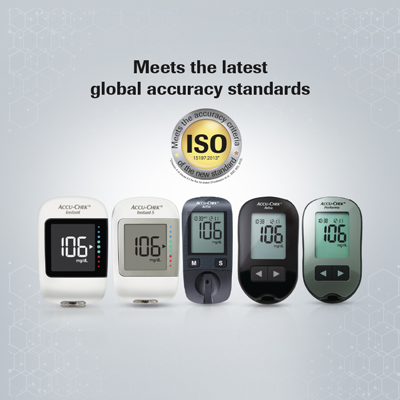Matching all aspects of the ISO 15197:2013 performance requirements for blood glucose monitoring systems
Accu-Chek brand of blood glucose monitoring products are compliant with the revised standards of IS/ISO 15197:2013 announced by Central Drugs Standards Control Organisation (CDSCO), Directorate General of Health Services, Ministry of Health & Family Welfare. What is ISO? ISO is the International Organization for Standardization headquartered in Switzerland, whose membership is comprised of national standards bodies from approximately 162 countries. ISO is an independent non-governmental organization. What is an ISO standard? An ISO standard is...
Read MoreCarbohydrate Counting and Exchanges
The truth about carbohydrates and diabetes The myth: If you have diabetes, you can't eat sweets or sugar. The truth: A food doesn't have to be sweet or sugary to raise your blood sugar. Anything with carbohydrates will affect your blood glucose, whether it's from white potatoes, pasta, bread or (insert local sweets here…jelly babies / lollies / strawberry laces).1 Of course, different foods may affect you differently. Why?...
Read MoreExercise more
Ways to Increase Activity Exercise is good for everyone, but for people with diabetes, it can make a big difference in keeping your blood sugar level under control. Not only that, but staying active allows your cells to process insulin more efficiently, improving your overall A1C levels. The many benefits to staying active Exercise is one of the cornerstones of managing your diabetes, because the list of benefits for people with diabetes is long. Exercise can:1 Improve insulin sensitivity for people with type 12 Decrease the glucose in your...
Read MoreTreating Low BG
Low blood glucose: Know the signs and steps to take You may recognize the feeling—feeling hungry, dizzy, sweaty or just a little bit "off." These signs of hypoglycaemia, or low blood glucose, mean it's time to take action. What causes low blood glucose? For most people, low blood glucose refers to anything below 4.0 mmol/L , although your number may be different.1 Low blood glucose can be caused by taking too much medication, not having enough to eat or exercising. In fact, hypoglycaemia can occur up to 12 hours after you've been...
Read MoreHypoglycemia
Hypoglycemia occurs when your blood glucose drops too low. The body responds to low blood glucose with warning signs that may be different in each person. Some warning signs of low blood glucose are feeling: Weak Shaky Sweaty Irritable or confused Hungry Low blood glucose may occur if your meal or snack is delayed or...
Read MoreThe Best Foods for PWD
Eating Healthy with Diabetes You don’t have to sacrifice your target blood sugar levels to enjoy some of your favorite foods. Here’s how to eat healthy with #diabetes, whether you’re cooking at home, or eating in a restaurant. Carbohydrates and your blood sugar Carbohydrates are sugars. They break down in the body creating glucose, a main source of energy. Counting the carbs you eat at every meal and pairing them with the correct dosage of insulin can keep your blood sugar level closer to normal range.1 It also allows you to eat a wider variety of foods....
Read MoreLiving in Range
Feeling your best—life in your target range When you find your mind wandering—thinking about the future—what do you see? Whether you dream about taking photos somewhere amazing or starting a family, or you'd simply like to have more energy or sleep through the night, keeping your blood glucose in line can help you achieve it. Sometimes it can seem like diabetes is all about the numbers. But your efforts to stay within your target ranges for blood glucose before and after meals, as well as meeting your HbA1c goal, are really about feeling your best today and for years to come ...
Read MorePain management
5 tips for gentle blood sampling Lancing fingers is a vital part of daily diabetes management. In a recent study, up to 35% of the participants stated that pain is the main reason people with diabetes refrain from regular blood glucose testing1.2One factor contributing to greater pain sensation when lancing the finger is wrong handling of the lancing device. Lancing correctly with Accu-Chek lancing devices keeps discomfort to a minimum. You can test more comfortably with these five easy steps: ...
Read MoreTips for Making Testing Easier
Whether you check your blood glucose level once a week, once a day, or 6 times a day, learning how to make testing easy and less painful may inspire you to test more often. For people with diabetes, the knowledge that you gain from testing is the key to staying in control of your health. It helps you make informed decisions about medicine, food, and exercise. It helps you cope with the day-to-day demands of living with diabetes, you’ll feel better each day, and you’ll lower your risk for future diabetes complications.1 Here are some tips for getting the best results possible. A guide...
Read MorePages
Carbohydrate Counting and Exchanges
The truth about carbohydrates and diabetes The myth: If you have diabetes, you can't eat sweets or sugar. The truth: A food doesn't have to be sweet or sugary to raise your blood sugar. Anything with carbohydrates will affect your blood glucose, whether it's from white potatoes, pasta, bread or (insert local sweets here…jelly babies / lollies / strawberry laces).1 Of course, different foods may affect you differently. Why?...
Read MoreExercise more
Ways to Increase Activity Exercise is good for everyone, but for people with diabetes, it can make a big difference in keeping your blood sugar level under control. Not only that, but staying active allows your cells to process insulin more efficiently, improving your overall A1C levels. The many benefits to staying active Exercise is one of the cornerstones of managing your diabetes, because the list of benefits for people with diabetes is long. Exercise can:1 Improve insulin sensitivity for people with type 12 Decrease the glucose in your...
Read MoreTreating Low BG
Low blood glucose: Know the signs and steps to take You may recognize the feeling—feeling hungry, dizzy, sweaty or just a little bit "off." These signs of hypoglycaemia, or low blood glucose, mean it's time to take action. What causes low blood glucose? For most people, low blood glucose refers to anything below 4.0 mmol/L , although your number may be different.1 Low blood glucose can be caused by taking too much medication, not having enough to eat or exercising. In fact, hypoglycaemia can occur up to 12 hours after you've been...
Read MoreHypoglycemia
Hypoglycemia occurs when your blood glucose drops too low. The body responds to low blood glucose with warning signs that may be different in each person. Some warning signs of low blood glucose are feeling: Weak Shaky Sweaty Irritable or confused Hungry Low blood glucose may occur if your meal or snack is delayed or...
Read MoreThe Best Foods for PWD
Eating Healthy with Diabetes You don’t have to sacrifice your target blood sugar levels to enjoy some of your favorite foods. Here’s how to eat healthy with #diabetes, whether you’re cooking at home, or eating in a restaurant. Carbohydrates and your blood sugar Carbohydrates are sugars. They break down in the body creating glucose, a main source of energy. Counting the carbs you eat at every meal and pairing them with the correct dosage of insulin can keep your blood sugar level closer to normal range.1 It also allows you to eat a wider variety of foods....
Read MoreLiving in Range
Feeling your best—life in your target range When you find your mind wandering—thinking about the future—what do you see? Whether you dream about taking photos somewhere amazing or starting a family, or you'd simply like to have more energy or sleep through the night, keeping your blood glucose in line can help you achieve it. Sometimes it can seem like diabetes is all about the numbers. But your efforts to stay within your target ranges for blood glucose before and after meals, as well as meeting your HbA1c goal, are really about feeling your best today and for years to come ...
Read MorePain management
5 tips for gentle blood sampling Lancing fingers is a vital part of daily diabetes management. In a recent study, up to 35% of the participants stated that pain is the main reason people with diabetes refrain from regular blood glucose testing1.2One factor contributing to greater pain sensation when lancing the finger is wrong handling of the lancing device. Lancing correctly with Accu-Chek lancing devices keeps discomfort to a minimum. You can test more comfortably with these five easy steps: ...
Read MoreTips for Making Testing Easier
Whether you check your blood glucose level once a week, once a day, or 6 times a day, learning how to make testing easy and less painful may inspire you to test more often. For people with diabetes, the knowledge that you gain from testing is the key to staying in control of your health. It helps you make informed decisions about medicine, food, and exercise. It helps you cope with the day-to-day demands of living with diabetes, you’ll feel better each day, and you’ll lower your risk for future diabetes complications.1 Here are some tips for getting the best results possible. A guide...
Read More








